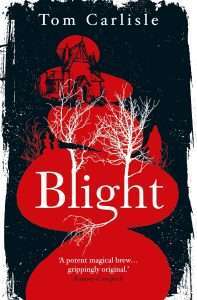Adrian Collins's Blog, page 79
October 16, 2023
REVIEW: Blight by Tom Carlisle
Blight is the debut novel from author Tom Carlisle. A traditional gothic novel, it has elements of horror, the arcane, and furtive goings-on. Blight is the perfect read for this time of year and would appeal to fans of modern writers like T. Kingfisher or Susan Hill or lovers of classic gothic novels. If you (like me) are a partaker of Neil Gaiman’s ‘All Hallows’ Read,’ Blight should be a contender for you to curl up with.
Set in the late 19th Century, Blight follows James Harringley as he is summoned to return to his ancestral home in the North of England. Against his better judgement, James comes home and has to face everything he has tried to forget. His father, formerly a fearsome man of strength and principle, seems to be losing his mind. His younger brother, Edward, attempts to keep up appearances and save the family’s reputation. And the Tall Man, something James has been desperately trying to forget, has taken another child.
I enjoy a gothic novel, and that is squarely where I would put Blight in terms of genre. Carlisle has put everything I love from gothic fiction in Blight. There are elements of the supernatural, a sustained sense of unease, and past traumas haunting the present. If I were to write a checklist for tropes of gothic fiction, Blight has them all. But Carlisle has done this very well. It can hold its own next to the classics while feeling like a new tale. Blight is a homage to the great gothic novels, not a copy. This story is not a retelling of something you have read before, and Carlisle’s twists and turns in Blight kept me engaged until the end.
Blight is a relatively short novel at just over three hundred pages, and it is well-paced. James is a well-written and relatable protagonist, which is essential as Blight is James’ journey of discovery. The plot is unpredictable, which means that the ending has some very satisfying surprises to it. There are some disturbing moments, and Carlisle is very good at playing with our fear of the unknown to keep the reader in a permanent state of discomfort rather than relying on sudden outbursts of overly explicit and extended violence.
Blight is described as an ‘uncanny folk horror,’ which is true, but this folk tale has nothing whimsical or cute about it. The novel might not be everyone’s cup of tea, but Blight will appeal greatly to some of our readers. Autumn is the perfect time to hide from the wind and the rain with a good gothic novel, and Blight is definitely that. Thank you very much to the Titan team and Tom Carlisle for sending Blight over.
3.5/5
Read Blight by Tom CarlisleThe post REVIEW: Blight by Tom Carlisle appeared first on Grimdark Magazine.
October 15, 2023
REVIEW: Killers of the Flower Moon
Killers of the Flower Moon has been a long time coming. Martin Scorsese’s latest epic has been in the works for some time and this three-and-a-half-hour epic set in 1920s Oklahoma has been garnering early Oscar buzz. Leonardo DiCaprio, Robert DeNiro, Jesse Plemmons, Brendan Fraser, and more unite in a stellar cast written and directed by a true legend of cinema.
Based on a powerful true crime novel by David Grann, Killers of the Flower Moon has Scorsese take a risk in turning a crime whodunnit into something much different. He chose to follow what he calls the ‘heart’ of the movie – the relationship between Leonardo DiCaprio’s Ernest Burkhart and the absolutely amazing Lily Gladstone playing Molly Kyle. It’s a long film with a huge first act where the scene is set. Oil is discovered by the Osage people and they become some of the richest people in the world. With such wealth comes danger and the chance for corruption. William ‘King’ Hale (an on form Robert DeNiro) is a local businessmen who seeks to get his cut of the Osage fortune through robbery, murder, and marriage and he manipulates his nephew Ernest into marrying Osage woman Molly Kyle as part of his dastardly plan. With Molly’s family falling foul to Hale’s plans one by one, suspicions grow but no one seems to care about the plight of the Osage people until word gets to Washington and a full investigation leads to further tension in Fairfax. The murders are grim and brutal and the lack of care from anyone nearby is sickening to watch in a tale based on truth. It is horrifying to see the way the powerful white man in Hale manipulates those who consider him a friend or family and then throws them away without a thought when they are not needed or when he stands to gain something from their death. He is a truly villainous character made all the more horrifying by the fact he is so human. DiCaprio and DeNiro both bring gravitas to their roles and the dark humour etched in the script is brilliant at times but it did sometimes feel that both actors had another fear to go into that was ignored. Instead it is Lily Gladstone’s performance as Molly that is the standout performance alongside those playing the haunted and persecuted Osage people. An Oscar nomination would not be a surprise.
The cinematography is stunning in Killers f the Flower Moon, as you would expect from a Scorsese film. The setting itself becomes a character, one haunted by the deaths of a proud people regretting the wealth thrust upon them and the changes it had brought. The story is heavy and full of intrigue as you watch Hale’s schemes play out but at times, I couldn’t help but feel that the story would have benefitted from a limited TV series on Apple instead of a release as a feature film. However, this is a true Scorsese film with an emphasis on big ideas found in small moments and the man is cinema personified. His name is up there with Kurosawa, Hitchcock and Spielberg amongst the list of greats and Killers of the Flower Moon is further roof of his expert craftsmanship, even if it may not be for everyone. It is not as entertaining as The Departed, witty as Goodfellas, or as raw as Raging Bull – but it has elements of all his great works and is a must watch for students of cinema.
Killers of the Flower Moon is a powerful, thought-provoking film full of beauty and grief. It has Scorsese’s incredible ability to blend epic scope with intimate moments and he draws out some incredible performances from a stacked cast. It is a film with a story that needs to be widely known but doesn’t quite hit the highs of his best work in terms of entertainment.
The post REVIEW: Killers of the Flower Moon appeared first on Grimdark Magazine.
October 14, 2023
REVIEW: The Banished by H.C. Newell
H.C. Newell captures the brutal aftermath of Curse of the Fallen with her novella, The Banished, which is essential reading for fans of Newell’s dark epic fantasy series, Fallen Light. While the main books of the Fallen Light series focus predominantly on Neer, a young woman cursed with forbidden magic, The Banished turns the spotlight to two of my favorite supporting characters: the elven warrior Avelloch and the halfling Gil.
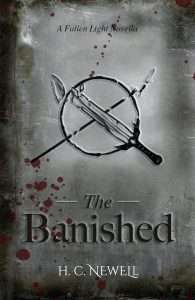 Emotions run raw throughout The Banished, which picks up immediately following the tragic ending of Curse of the Fallen, the first book of the Fallen Light series. Since I don’t want to spoil the conclusion of Newell’s debut novel, let me just say the characters are physically and psychologically broken, suffering from both bodily injury and post-traumatic stress.
Emotions run raw throughout The Banished, which picks up immediately following the tragic ending of Curse of the Fallen, the first book of the Fallen Light series. Since I don’t want to spoil the conclusion of Newell’s debut novel, let me just say the characters are physically and psychologically broken, suffering from both bodily injury and post-traumatic stress.
Most of The Banished is told from the perspective of Avelloch, who returns to his homeland, the elven forest of Nyn’Dira, to find solace and hopefully to heal his weary heart. However, Avelloch is caught in the middle of a human invasion of the elven forest, needing to defend his relationship with Neer. Avelloch discovers that the threat to Nyn’Dira may be worse than initially meets the eye, with greater implications for the entire land of Laeroth.
Avelloch shares point-of-view duties with Gil, the shapeshifting halfling who is another close friend of Neer. The relationships between characters are truly a highlight of The Banished, testing the limits of both friendships and familial relationships.
Although worldbuilding takes a backseat in The Banished to focus on H.C. Newell’s outstanding character work, the novella fills in some important gaps left in the main books of the series. There are also some unexpected revelations that will change your perspective on the events of the Fallen Light series.
Already a talented storyteller, H.C. Newell elevates her writing craft to new artistic heights in The Banished, capturing the deep emotions of the characters. It helps that she has slowed down the pacing of the novella compared to the main books of the series, giving her characters the time to reflect and deal with their emotional trauma.
The Banished is a must-read for fans of H.C. Newell’s Fallen Light series, providing additional depth to several of the key characters. The novella format works well for delivering a character-focused story that packs a big emotional punch. The series continues with The Forbidden Realms and the upcoming Shadows of Nyn’Dira.
5/5
Read The Banished by H.C. Newell
The post REVIEW: The Banished by H.C. Newell appeared first on Grimdark Magazine.
REVIEW: Starling House by Alix E. Harrow
Alix E. Harrow has this knack for writing characters like bruised steel. It’s specifically those dents, scratches, and ugliness that make her work stick out as more enchanting than the entirety of book releases you’ve read in the past year. The Six Deaths of the Saint made me realize Alix E. Harrow was the author for me. She painted a darker world in forty pages with more agonizing emotional impact than over-bloated grim descriptions could ever do. She makes everyone quake in their boots, and for a good reason. Starling House very equally made me shake and shiver.
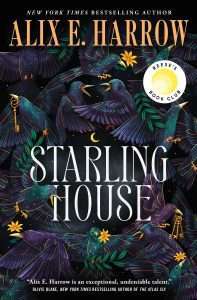 In Starling House, Harrow splits apart the archetypical structure of fairy tales and transforms it into a Southern Gothic. And it’s the gothic structures that inspired Opal to tell haunted stories to her little brother in their motel room as they scraped by every day in the former coal miner town of Eden, Kentucky. Opal’s story is a truth for many kids in the United States. One marked by the other kids sensing the hunger behind Opal’s smile. And apparently also some animalistic fear that she would kill every single one of them. The classically pretty fairytale princess with luck on her sleeve and a godmother’s promise of a handsome, rich prince is exchanged for what we really want: an acidic gothic heroine and haunted Heathcliff with a face resembling a crow.
In Starling House, Harrow splits apart the archetypical structure of fairy tales and transforms it into a Southern Gothic. And it’s the gothic structures that inspired Opal to tell haunted stories to her little brother in their motel room as they scraped by every day in the former coal miner town of Eden, Kentucky. Opal’s story is a truth for many kids in the United States. One marked by the other kids sensing the hunger behind Opal’s smile. And apparently also some animalistic fear that she would kill every single one of them. The classically pretty fairytale princess with luck on her sleeve and a godmother’s promise of a handsome, rich prince is exchanged for what we really want: an acidic gothic heroine and haunted Heathcliff with a face resembling a crow.
But haunted stories are what has made Opal so curious about Starling place, the grand house belonging to a long line of wealthy eccentrics who never seem to show their faces in town. Opal hasn’t allowed herself to dream of Starling since her mom died. The only dreams she caters to are those belonging to her brother. But recently, Starling feels as though it’s reaching, preying for her. Even the new heir can see it trying to get its claws into her. Finding herself pulled into this decayed catastrophe of a house, Opal suddenly finds herself with a new, better-paying opportunity to get her brother out of Eden. When it’s discovered that she’s been cleaning Starling House, a stranger promises financial support for her brother’s dreams. But even for Opal and her not-very squeaky-clean ethical compass, the price of betrayal leads her to more questions about the history of Starling House and its long reign of heirs.
Starling House is like a treasure trove‑full of dusty, monstrous horror story tomes piled around a nerd screaming for a solution to his family’s curse. Because much like the Dutchman needs a captain, Starling House needs a warden to prevent the nightmares from escaping. This is a charming and haunting tale. It’s got the right way of things as Gothics go, something that is lost in this publishing trend. This is a Southern Gothic that goes deep, studying the very facets of the subgenre by balancing its history with the more contemporary costuming of the Gothic. As is her tradition, Harrow looks at the classics but cuts it up like a well-taught surgeon. I love to sink into a story that feels like the author is having fun with unlikeable, miserable people battling monsters and kissing the blood off each other.
Starling House is eerily like the real world we know but are all desperate to escape. Two miserable, but intensely romantic couple is more than a good escape. It’s just the type of dark, romantic, and spooky world I would want to enter if I were to pick up something for Halloween.
Read Starling House by Alix E. Harrow
The post REVIEW: Starling House by Alix E. Harrow appeared first on Grimdark Magazine.
October 12, 2023
REVIEW: The City of Marble and Blood by Howard Andrew Jones
Book 2 in Chronicles of Hanuvar, The City of Marble and Blood picks up shortly after the conclusion of Lord of a Shattered Land. Defeated general and master strategist Hanuvar continues his undercover efforts to free his enslaved Volani countrymen from the genocidal Dervan Empire. He reconnects with old allies and gains new ones, including some surprising friends highly placed within the Dervan Empire. Early in the book a sorcerous mishap inflicts upon Hanuvar a startling transformation, however. The magical disaster provides renewed physical vigor and makes disguising his identity easier, but he also finds himself unrecognizable to longtime friends and aging at an accelerating pace. Freeing his people remains his utmost priority, but even more than before Hanuvar is confronted with his own mortality.
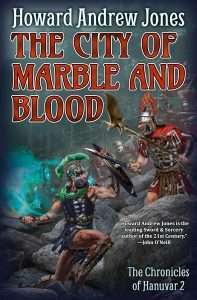 Like Lord of a Shattered Land before it, The City of Marble and Blood is another cycle of 14 linked stories (the final 15th chapter is more of an epilogue). Each chapter is largely episodic, making this an ideal book for short reading sessions. Compared to the first volume, however, The City of Marble and Blood holds together better as a cohesive novel. Where the installments in Lord of a Shattered Land tended to be scattered both geographically and thematically, with few members of the supporting cast returning after their original appearance, the stories here share more recurring characters and the plots more connections between them.
Like Lord of a Shattered Land before it, The City of Marble and Blood is another cycle of 14 linked stories (the final 15th chapter is more of an epilogue). Each chapter is largely episodic, making this an ideal book for short reading sessions. Compared to the first volume, however, The City of Marble and Blood holds together better as a cohesive novel. Where the installments in Lord of a Shattered Land tended to be scattered both geographically and thematically, with few members of the supporting cast returning after their original appearance, the stories here share more recurring characters and the plots more connections between them.
While Hanuvar remains as clever and driven as ever, the type of stories being told in The City of Marble and Blood have shifted slightly compared to the preceding book. Where Lord of a Shattered Land took place in the outlying provinces, The City of Marble and Blood is largely set deep behind enemy lines, either in the Empire’s central territories or the capital of Derva itself. This change in locale raises the stakes, as Hanuvar is surrounded at all times by the imperial war machine and the Gestapo-like Revenants. The capture and interrogation of Hanuvar or one of his key allies has the potential to scuttle his entire plan to liberate the enslaved Volani. And while they don’t disappear entirely, the “man versus monster” stories from the first volume mostly give way to a greater focus on mystery and political intrigue. Hanuvar finds himself in the uncomfortable position of working to foil assassination attempts on Dervans responsible for the destruction of his homeland, simply to prevent the ascension of even worse figures.
Fewer supernatural monsters appear in The City of Marble and Blood than the first book, but there is a greater emphasis on humanocentric evil. While there are a number of likable Dervan characters, it remains an empire built on slavery and Jones doesn’t shy away from depicting the brutality of human bondage. Entitled “In a Family Way,” the eleventh story in the book is an incredibly bleak look at a Dervan lordling who surrounds himself with beautiful slaves. Not only are the women mistreated and forced to share his bed, those unfortunates who fall pregnant end up being subjected to an even more sadistic fate. Hanuvar is an unambiguously heroic figure and many of his adventures have bright conclusions, but when a story wanders into grim territory Jones seems happy to rip the gloves off and bolt deeper into the darkness.
Lord of a Shattered Land marked a strong start to Chronicles of Hanuvar and The City of Marble and Blood makes for a compelling follow-up. The nature of Hanuvar’s exploits have changed slightly, but he remains the same cunning and cerebral character introduced in the first book. He also now benefits from an expanded roster of interesting and engaging allies and foes. The Roman-inspired Dervan setting continues to intrigue. Jones provides enough detail to paint a vivid picture of the society while simultaneously avoiding the dreaded “info-dump.” The City of Marble and Blood delivers a definite sense of forward momentum that I found incredibly satisfying. Formidable obstacles remain, but it feels like Hanuvar is making significant progress towards liberating his people. He’s winning. This makes me suspect that readers are being set up for a devastating reversal of fortune in the third book.
While The City of Marble and Blood appeared merely two months after Lord of a Shattered Land, readers will have to wait notably longer for the third volume in the series. Shadow of the Smoking Mountain is scheduled for an October 2024 release.
Read The City of Marble and Blood by Howard Andrew JonesThe post REVIEW: The City of Marble and Blood by Howard Andrew Jones appeared first on Grimdark Magazine.
October 11, 2023
An Interview with Kell Woods
Kell Woods is the debut author of After the Forest, a dark fantasy inspired by the tales of the Brothers Grimm. Her novel starts after the happy end of the story as we know it, and hones in on the trauma that would arise from it. We loved After the Forest – see our review here – and are very excited that we got to speak to Kell to celebrate the release.
 [GdM] After the Forest is the story of what happens after the witch is defeated. What inspired you to ask these questions and turn them into a novel?
[GdM] After the Forest is the story of what happens after the witch is defeated. What inspired you to ask these questions and turn them into a novel?
[KW] I was interested in delving into a fairy tale and turning it inside out – exposing the red lining, you could say. The tale of Hansel and Gretel is a familiar one for most of us, but I wanted to explore what things might have been like if Hansel and Gretel were real people, in a real place and time. What kind of adults would they be? What would their lives be like?
Picture two children who have recently lost their mother. Shortly after, their father remarries and then, under pressure from his new wife, abandons them in the woods. They’re alone and lost in the forest for three days before they’re abducted by a cannibalistic witch. To save her brother’s life and her own, Gretel pushes the witch into her own oven, killing her.
This is some seriously grim stuff. And the more I thought about it, the more I wondered how the woodcutter could have brought himself to abandon his children. And why the witch chose Hansel, not Gretel, for dinner. And how Gretel would have felt after that push. And whether any of them would have really been capable of living happily ever after.
[GdM] I found that After the Forest doesn’t only reference fairy tales, but is truly in conversation with them, having similar narrative structures. What do you think makes these stories so distinctive and enthralling to readers?
[KW] Fairy tales are so old and have been told by so many different people over the centuries that they seem almost timeless. ‘Once upon a time.’ There’s something about those four familiar little words that instantly transports us out of the real world and into another. It is the world of our childhoods, where anything is possible – magic and fantastical creatures and danger. These stories are very dark and often strange and brutal, especially the older versions. But they are filled with beauty, too. I think it’s this combination of beauty, brutality and agelessness that calls us back to them again and again.
[GdM] If you had to pick, what story from the Brothers Grimm’s collection is your favourite and why?
[KW] I have to say Snow White. That iconic poisoned apple gets me every time. It’s so creepy and so dark.
[GdM] What do you think makes a great retelling?
[KW] I think a good re-telling is one that stays true to the original – hits all the familiar beats we know, love and expect – but adds a new depth. Two of my favourites are Bitter Greens by Kate Forsyth and Daughter of the Forest by Juliet Marillier. Sea Hearts by Margo Lanagan builds a new story around selkie lore – it’s wonderful, too.
[GdM] You are being published by three different publishers in three territories. What has that experience been like, and what are some of the differences you’ve experienced?
[KW] It’s been incredibly exciting, and at the same time intensely scary. I have three wonderful teams looking after the book and me, which is great. The timezone differences can be challenging, but other than that things have gone smoothly. The most obvious difference was the book’s covers. Each territory wanted something different and it was wonderful to see three different versions of the cover come to life. Funnily enough Andrew Davis, a UK designer, designed both the US and the AU/NZ covers.
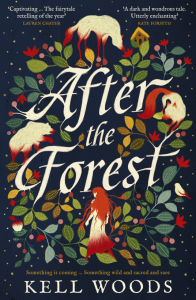
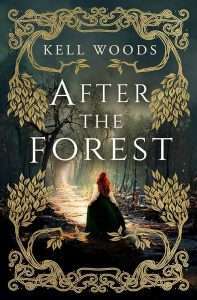

[Editor’s note: see the three very different covers side-by-side]
[GdM] After the Forest is a fantasy novel set in a real-world historical setting. What sort of research did you do, and what has maybe surprised you within that?
[KW] I did a lot of research on life in Early Modern Germany. Clothing, food, daily life, things like that. I tried to make the setting as accurate and detailed as possible. I went to the Black Forest too, which was amazing. Gorgeous little villages with half-timbered houses set in valleys with rivers running through them, surrounded by steep, forested mountains. I went to a bear and wolf sanctuary, and out into the woods with a forest guide. I travelled alone with a backpack and a truly appalling grasp on the German language – got lost, missed buses, all the usual stumblings – but I picked up so many details I couldn’t have gotten from books and the internet alone.
[GdM] Let’s talk villains. You’ve got a great villainess in After the Forest. Without going into spoilers, what makes a great villain for you?
[KW] In one word? Depth. I love villains that have good reasons for doing what they’re doing. Or who are simply likeable, you know? Humour goes a long way. It all comes down to choices, I think. Humans make good choices and bad choices all the time – they’re rarely truly good or truly evil.
[GdM] One of the core themes I kept coming across in After the Forest was powerlessness in its many forms – from Hans’ gambling problem, to Greta’s social role, to many, many others. Was this threaded through the story intentionally?
[KW] I don’t think so. I feel like maybe the strictures of the time might have helped shape it that way. Almost every character in the book is living with some kind of trauma – I was intentional about that, so perhaps there is a connection there.
[GdM] What books or other media have been filling your creative well recently?
[KW] Lots of different things. I’m re-reading The Book of Lost Things by John Connolly so I can read his new one, The Land of Lost Things. I love it! Empire of the Vampire by Jay Kristoff knocked my socks off, it was so good and so consuming. I couldn’t put it down. I listen to a lot of music, film scores mostly, so I always have something beautiful playing. I loved Frances O’Connor’s movie Emily, too. So wild and beautiful. You gotta keep filling that well!
[GdM] Can you tell us anything about what you’re working on next?
[KW] After the Forest is the first of a two-book deal so I’m about to get into editing the second book. It’s early days so I can’t say much, but I can say that it’s a standalone novel that re-tells another well-known fairy tale – one that’s set under the sea.
Read After the Forest by Kell WoodsThe post An Interview with Kell Woods appeared first on Grimdark Magazine.
October 10, 2023
REVIEW: Blood Harvest by Richard Swan
In Blood Harvest, the latest Warhammer 40,000 short story release from Black Library, Conscript Mukta is hiding in a farming machine waiting to die, holding an old lasgun on an agri world being overrun by an unending horde of tyranids. With Richard Swan—a favourite author of mine from his Empire of the Wolf fantasy series and his brilliant The Art of War space opera series—as the latest big name fantasy author to join the Black Library stable, I was keen as mustard to get stuck into this tale.
 Blood Harvest is a short story that I feel really embodies the short brutal lives of the stock standard soldier of the Imperium’s planetary defence forces. Not the men and women of the Astra Militarum being ferried from battlefield to battlefield, but home defence regiments who never leave their planets, maybe train on the weekends, and then are expected to stand tall against the nastiest things in the galaxy. Woefully inexperienced, underequipped, and laughably trained, in my mind they are usually meat for the grinder in the hope some piece of gristle in them gets caught in the enemy’s gears.
Blood Harvest is a short story that I feel really embodies the short brutal lives of the stock standard soldier of the Imperium’s planetary defence forces. Not the men and women of the Astra Militarum being ferried from battlefield to battlefield, but home defence regiments who never leave their planets, maybe train on the weekends, and then are expected to stand tall against the nastiest things in the galaxy. Woefully inexperienced, underequipped, and laughably trained, in my mind they are usually meat for the grinder in the hope some piece of gristle in them gets caught in the enemy’s gears.
What Blood Harvest does well is show the sheer level of escalation in both the personal martial capabilities of the soldiers of the Imperium, and also the ridiculous scale at which battles are fought. With that scale comes scale of repercussions for mistakes, something that always made me think of battles from our world wars–just dialled up to eleven.
The ending of Blood Harvest didn’t land with the kind of punch I’d generally like to get from a short story, but it certainly left plenty of future page space for more stories of Mukta Lim, the Tempestus Scions, and the battle against the Tyranids. This short story is well worth your time, and retains the action packed nature of this military sci fantasy universe while delving into a colossal group of humanity’s defenders rarely delved into.
Read Blood Harvest by Richard SwanThe post REVIEW: Blood Harvest by Richard Swan appeared first on Grimdark Magazine.
Diablo IV gets faster, darker, and more vampirey with Season of Blood
The seasonal release approach to the magnificent Diablo IV is starting to really hum with the announcement of the Season of Blood, where vampires come out of the age old Sanctuary lore and shift from being a rather annoying trait of enemy elites, and becomes something far more terrifying and fun.
There is plenty to get excited about in the trailer for Season of Blood, and I personally can’t wait to plonk myself on the couch and play a dark, bloody, moody, and mechanically faster season of Diablo IV. We were fortunate enough to sit down with the Blizzard team this week and find out a little more about what players can expect when the new season releases on October 17th.
Season of Blood: creating a vampire themed season that doesn’t suckThe Diablo world has had vampiric as a trait for a long time (shout out to all my comrades who have been on the cusp of an unlikely fight victory, only to have their last bit of health sucked from them by a sword stab), but vampires haven’t really played much of key character role thus far. When asked about why the team chose to go with a vampire season, Lead Designer Timothy Ismay said:
It is mostly a thing you run into, you know, monsters are vampiric or are vampires and you kill them and move on. We actually wanted to to dive into that because there is a more robust lore here. Vampires have existed for a very long time in Sanctuary, you know, thousands of years, back to the ancient early men. There were influences there that we haven’t really dived into it. So, this is the first place where we’re actually touching on that a bit. Where we’re actually saying, ‘You’re going to meet a vampire lord, someone who is very ancient… very powerful, leads and controls other vampires, and has decided that this is the time to make his move’.
Creating the Season of Blood storyline and characters and central driving force really feels like a step up for the Diablo production team compared to season one. From what we’re seeing so far, it’s more of a seasonal expansion with a new boss (and, if you check the release notes, more bosses!), versus a thematic season wrap on the same game using all the same tools and kit.
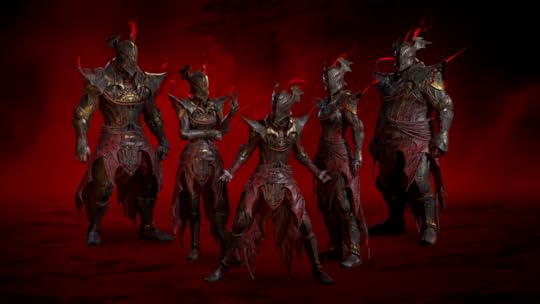
As we’ve said in our two reviews of Diablo IV (pre-release and post-release) this game is completely and utterly fucking gorgeous. From day one, the art team has done an amazing job in creating a world that is both beautiful, dark, moody, and also does not impose itself between you and playing the game. I was therefore so excited to hear that Lead Artist Kymba Plushner (Diablo III and Diablo IV) was also joining the call to talk about how she and her team helped provide the visual brilliance for Season of Blood. When asked about the challenges of working in a creative behemoth like Diablo IV and the Season of Blood, Plushner said:
I grew up loving a lot of dark gothic fantasy… and I feel like a lot of the artists here also have that sentiment that it’s an aesthetic we really dig. One of the big things is being able to have a shared creative vision, you know, a dozen different people will come to you with a dozen different ideas of how things could and should look, and you have to be able to try and find that kind of concentrated cool and what fits the world and the stories that we’re trying to tell, as well as to make sure that the various art styles and disciplines seamlessly blend together.
Based on the current game and the release trailers and the short depictions we’ve seen Plusher’s team develop, I am really looking forward to seeing how they depict the new mechanics, characters, and gameplay styles that Ismay’s team have designed.
Speeding up the game even moreIn Diablo I, you walked everywhere, and if you ran out of Town Portals, you settled in for a really long walk back to a waypoint. In Diablo 2, all of a sudden you could run, and in some cases jump. The game needed speeding up so that you could focus on killing things and searching for items, and they delivered that. In Diablo IV some absolute legend took that a step further and created horses so you could get from location to location even faster, and could burst through or run around masses of enemies you may not want to invest time in fighting.
Ismay and his team have made this season even faster again, doing their best to focus on removing the hurdles, “players (are) actively calling out as pain points–so, things that they have to do that are tedious and not particular immersive.” If you look through the release notes, you’ll see a laundry list of changes that impact game speed, such as 15% faster baseline speed for horses, the Purveyor of curiosities moved closer to waypoints, removal of dungeon missions outlasting the final boss, 40% faster levelling up to 100, and many, many more. When asked about the decision behind this need for speed, and in trying to find a balance between speed of play and enjoying the environment, Ismay said:
We want there to be things found in the environment. We want players to explore. We want them to feel rewarded for seeing something important… but sometimes players just want to get where they are going. You know, they’ve already decided exactly what they are going to do–they want to be able to just run to that point… So players have called out a bunch of pain points, and we fully agree. (For example) Mounts should be a little bit faster; the barricades are not fun, we just want you to be able to smash through those when you hit your spurs. And mounts getting stuck on stuff–that was certainly not by design. It’s not like (the team thought) ‘Oh, it’s great getting stuck on a rock!’ So, it’s literally been about fixing bugs (in this instance).
In particular, Ismay spoke about the 40% reduction in time to get from level 51-100:
We saw a lot of feedback from players, and were experiencing it ourselves, that one of the goals people like to set for themselves in a season is to get to level one hundred… We thought that one-to-fifty feels pretty good, but fifty-to-one hundred takes a very long time. Since more people are expressing that this is a (seasonal) goal they want to hit–add in to that we’re actually adding more things to do in the end-game; we’re adding in those additional end game bosses in season two–we really want more players to be able to experience this. Now, was it an easy decision? No. We can make that adjustment fairly easily in the game. But there are a lot of other systems that interact with this, so we have to carefully assess or even adjust those other systems to make sure they still interact in a way that is fun and compelling for the player.
When you consider the complexity of such a game, and the amount of adjustments made for Season of Blood (refer to the release notes here), this would be no small feat to adjust. While personally I generally start to mentally switch off on a game once the storyline is completed (one of the reasons I’m so excited about some new story villains in this season), Diablo’s fans are renown for their commitment to grinding out the long term game win, and I’m sure there will be plenty of players very happy with this change.
Improving upon an artistic masterpiece with Season of BloodAs we’ve said again and again, Diablo IV is visually gorgeous. I knew this was something special when, during my first play through, I wound up on a beach and for the first time thought that an art team had managed to get past the beach version of the uncanny valley. This was made more interesting when Plushner commented on my love of that environment that the beach art scenes started out as their team going to beaches and creating oil paintings of the locations.
Needless to say, the art team has an incredibly high benchmark to meet when depicting Season of Blood due to their incredible work leading up to this point. Plushner spoke about what her team was most proud of creating for this new season.
For this season specifically, I think some of the things we did with the vampire culture is just really fun and compelling… One of the things that we did this time that really sunk into Diablo (Season of Blood) was this combined feeling of, okay, it’s a very ancient race, so you’re having these sorts of vibes as well as this sort of rich gilded opulence that I think you don’t usually see there, and having this blend of this beautiful macabre kind of feel with the gold and you also have places where there are these elegant marble statues filled with blood that is pouring like a fountain… It creates this fun contrast of realising a deep-rooted culture that has a lot of pride in itself and is really trying to rise. I think we’ll see that both in some of the vampire areas as well as the boss arena where you’ll have your final stand against Lord Zier, which I don’t want to spoil, but it’s just beautifully, beautifully tricked out.
Being able to see the sheer level of excitement Plushner had for her team’s work in bringing the story of Sanctuary’s vampires to life was incredible, and just has me itching for October 17th to get here.
Time to reconsider your playing styleSeason of Blood is going to give you the opportunity to change. And to me, that is awesome. New game and character mechanics to take on a new kind of foe is likely to force you to rethink your build, and I feel that Diablo players new and old are going to love this aspect of this season as it breathes genuine new life into your purchase.
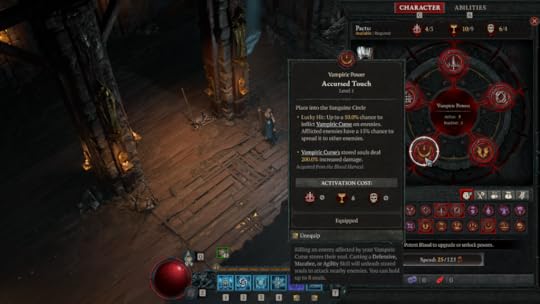
Ismay said:
It’s always fun to give the player new power in a unique way that they haven’t had before. So, the vampiric powers that we’re giving them (the players) do give them a chance to hopefully have a little bit of that vampire fantasy. You don’t fully become a vampire, but you get some of that power, and finding ways to integrate that into your build can be exciting.
Knowing the Diablo community, it won’t be long before peak characters are back in play making best use of all the new opportunity this season brings.
What else do they have in store for us?Being the Diablo II tragic that I am, I also asked if mercenaries would be coming back. Ismay said:
I can’t speak to any specifics. All I can say right now is that I also am a big Diablo II fan and played thousands of hours of it, had a chance to work on patches when I joined the company early on. We are looking at lots of different systems, including things that were in previous Diablo games to see what could make sense for future seasonal content or content that might come out in an expansion to the game.
I’m taking that as a secretive and tentative “yes”, and while I wait to get my Iron Wolf back, I’m going to have as much fun as possible getting stuck into Season of Blood on October 17.
(ed: a big thank you to Nathanael at Blizzard for organising this interview, and to Sally Berrow for her help with the questions and quote choices.)
The post Diablo IV gets faster, darker, and more vampirey with Season of Blood appeared first on Grimdark Magazine.
October 9, 2023
An interview with Thiago Abdalla
Thiago Abdalla is author of the highly acclaimed dark epic fantasy series, the Ashes of Avarin, which kicks off with A Touch of Light, a finalist in Mark Lawrence’s 8th Self-Published Fantasy Blog-Off (SPFBO8). The action continues with A Shade of Madness, the second book of the series. Abdalla has also published a prequel novella to the series, A Prelude to Ashes. The third volume, A Twist of Faith, will be released in late 2023 (you can check out a free excerpt here).
A Brazilian by birth, Abdalla grew up in the fantasy lands of Middle-earth, Azeroth, etc., which inspired him to create his own fantasy world. I recently had the pleasure of discussing with Thiago Abdalla about his fantasy world, literary inspirations, SPFBO8, and more.
 [GdM] First, congratulations on A Touch of Light being selected as a finalist in SPFBO8, a very well-deserved recognition for your outstanding debut novel. Could you tell us about your experience as an SPFBO entrant and later as a finalist? I am always impressed with the sense of camaraderie that seems to develop among the finalists.
[GdM] First, congratulations on A Touch of Light being selected as a finalist in SPFBO8, a very well-deserved recognition for your outstanding debut novel. Could you tell us about your experience as an SPFBO entrant and later as a finalist? I am always impressed with the sense of camaraderie that seems to develop among the finalists.
[TA] Thank you so much! It’s been such a crazy ride with this being my debut novel. So many new and rewarding experiences and probably most among them is SPFBO. Participating in SPFBO meant a lot to me firstly because it was created by Mark Lawrence, who, as you know, is my favorite author and someone I’ve been lucky enough to interact with. I admire Mark’s work on so many levels, so participating in “his” competition meant a lot.
The camaraderie, as you say, was the other big point from the competition. Fellow entrants, like Andrew Meredith, have become some of my closest friends.
Being a finalist was an incredible recognition for the first book I ever attempted writing. It took some time to sink in and I’m still not sure I believe it was all real.
[GdM] What recommendations would you have for other indie authors who are considering submitting their work to a future SPFBO?
[TA] The competition can be stressful as you wait for your book to be read and see others being cut. There’s also a fair share of luck involved. My recommendation would be to work on your book the best you can, and get professional editing if you can afford it. Be proud of what you’re submitting, then, and this might sound weird, forget about it. The competition is great, but only ten books out of three hundred get to the finals, your book isn’t bad if you’re cut (hence why my suggestion is to be proud of what you submit regardless). There are a ton of books that have been cut at every stage that still find massive success.
[GdM] A Touch of Light is noted for its Malazan-style worldbuilding which largely forgoes handholding for the reader. How did you decide to embrace this immersive style of worldbuilding?
[TA] I honestly wasn’t going for Malazan haha. I just really like being in the character’s skin and at moments I thought: well, the character knows this certain information already, they’re not going to explain it to themselves purely for the benefit of the reader. To me that feels like a professional swimmer thinking to himself how to perform the basic movements of a backstroke. It just doesn’t happen (or maybe it does, I’m a terrible swimmer and know nothing about professional swimming). I still find ways to show the reader the important stuff, but it’s heavily skewered toward showing rather than telling. With that said, I believe the important things are explained at the right time, so I’d suggest going with the flow and trusting that answers will come.
[GdM] The subject of death is taboo for one of the main religions in the Ashes of Avarin series. How did you develop this concept as one of the core beliefs of the Domain?
[TA] I’ve always had a particular view of death. I’ve had family members suffer like they’d lost a limb and I respect that, but my way of dealing with it was always different. I try to remember the good and tell myself I’ll meet the person again someday, even if we’re both spirits or something. It’s just a matter of time. This kind of thinking has always made me look a little cold I think. I’m never the person crying or caught in desperate grief and I’ve been judged by this reaction, or felt judged at least, as if I didn’t care for the person like everyone else who was crying. That sparked the idea, what if people couldn’t cry or grieve, or even talk about death? How would that affect a society? It all snowballed from there.
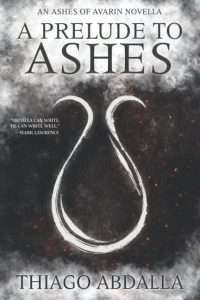 [GdM] For readers who are new to your series, do you recommend starting with A Touch of Light or your prequel novella, A Prelude to Ashes?
[GdM] For readers who are new to your series, do you recommend starting with A Touch of Light or your prequel novella, A Prelude to Ashes?
[TA] It depends on your reading style. If you don’t mind a big world, a large cast and a learn as you go type of storytelling, I’d recommend A Touch of Light. If you’d like to start with a more contained setting and be eased into some of the concepts of the world so that you have something to hold on to when the larger world of the novel engulfs you, then start with A Prelude to Ashes.
[GdM] Griffins feature prominently throughout the Ashes of Avarin series. What is it that has drawn you to griffins over more traditional dragons?
[TA] Everyone does dragons and I’m a hipster wannabe is the short answer. In seriousness, though, griffins are just damn cool and I really don’t know why more people don’t use them. I felt like so many people had already done dragons and I wasn’t confident I could add anything extremely original if I chose them.
[GdM] I love the emotion-based bonds that Sentinels such as Lynn form with their griffins. How did you develop this particular aspect of your magic system?
[TA] Emotions are our magic powers in real life. How many times have you not seen someone taken by anger that seems to have super strength? Or so happy they believe nothing can go wrong and it doesn’t? I just thought it was a cool bridge to our reality. A kind of ‘what if’ for readers. Developing it was hard because I didn’t want to fall into the same descriptive patterns. Also, were not always conscious of our emotions and that they are affecting us in the heat of the moment, so it was a fine line to tread. I think people will have to read the books to decide if I succeeded.
[GdM] You introduced a new point of view character in A Shade of Madness. Could you tell us more about Kadmus and how he came to be?
[TA] I had the concept for him since outlining the series, so he’s been simmering in my brain even before I started writing A Touch of Light. I just really liked the concept of a healer that’s not black and white. In fact, Kadmus is extremely selfish and has his own reasons for healing people. He’s cold and detached which hearkens back to how people have judged my reaction to death, but at the same time, there’s something extremely human driving Kadmus. That objective (no spoilers) trumps all and one might even say Kadmus isn’t really selfish, he’s just blindly determined to succeed and will pay any price for it.
[GdM] Your loyal fans are eager to know: what can we expect in A Twist of Faith, the third book of your series? A Shade of Madness is quite a bit darker than A Touch of Light. Will this trend continue with A Twist of Faith?
[TA] Yes. Yes, yes, yes. My characters are so screwed. A Twist of Faith will have characters facing their ultimate decisions and where they fall at the end will ultimately shape the events to come in the final book of the series. Their trials will require a lot though, and I’d say it gets pretty dark.
[GdM] How many books are you planning in total for the Ashes of Avarin series? Are there any additional novellas or short stories in the works?
[TA] Four books. I have ideas for novellas and I’d love to write them, but we’ll see how fast I can finish the main series first.
[GdM] You’ve recently released a line of merchandise featuring the four glyphs from your series. Could you tell us more about these symbols and what they represent?
[TA] Those are the four Signs of the Seraph: The Breath and the Body, the Blood and the Bone. The idea, besides the cool alliteration, is that each of these is a branch of the church. The Sentinels represent the Breath, the Bishops of the Bone represent… the Bone and are experts at intelligence, the Priests of the Blood represent the Blood and are magic users focused on healing. The Body is represented by the faithful who make up the body of the faith. I’m really happy with those symbols. The concept was mine, but a good friend of mine drew them and I just loved the result. I even used the Sign of the Blood on the cover of A Prelude to Ashes because the main character is Adrian and well, if you’ve read A Shade of Madness, you know what his relationship to blood is.
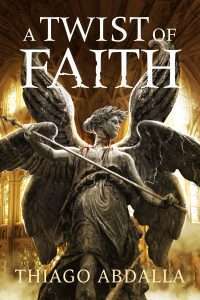 [GdM] You’ve commented that Mark Lawrence is one of your greatest literary influences. His novels are so diverse, covering everything from grimdark fantasy to traditional epic fantasy and time-traveling sci-fi. Could you tell us more about Mark Lawrence’s specific influences on your writing? Do you have a favorite among his large catalog of books?
[GdM] You’ve commented that Mark Lawrence is one of your greatest literary influences. His novels are so diverse, covering everything from grimdark fantasy to traditional epic fantasy and time-traveling sci-fi. Could you tell us more about Mark Lawrence’s specific influences on your writing? Do you have a favorite among his large catalog of books?
[TA] I think first and foremost, the prose. I’m not comparing mine to his, I’ll always think his prose is unbeatable, but I think I’ve picked up a few things that helped shape my style of writing and just having prose as something I value and work on. I also really appreciate Mark’s character development and the relationships they have. His characters have a very well set core that will drive them to the ends of the Earth, but they’ll never waver from who they truly are, even of they evolve and grow (Nona comes to mind). I absolutely love that and think I based some characters off of this writing concept. The rest is probably subconscious since I’ve read so many of his books. My favorite(s) are without a doubt The Book That Wouldn’t Burn (his latest book, which is astoundingly good), and The Girl and the Moon, that is just a love letter to any Mark Lawrence fan.
[GdM] Who are some of your biggest literary influences beyond Mark Lawrence?
[TA] I’ve enjoyed a lot of Joe Abercrombie, Patrick Rothfuss, Daniel Abraham, N. K. Jemisin, George R. R. Martin, among others. They’ve all definitely had an influence on my writing in one way or another.
[GdM] Your books are also known for their absolutely stunning covers. Could you describe your process for developing these covers together with the wonderfully talented Alejandro Colucci? Do you work closely together to get all the details just right?
[TA] Most of the work went into developing the concept for book 1. After that, Alejandro just nailed what a cover in this series should look like. Developing the concept is a lengthy process, though. I researched the fantasy cover market a ton to get to where I wanted. Your cover has to be unique, but still be within what a reader expects of a fantasy cover. I have a whole PowerPoint presentation I can share haha.
[GdM] I know we should not speak of the dead, but inquiring minds must ask. Why do you hate raisins, Thiago? Were they the source of some childhood trauma?
[TA] They are a pointless, wretched, twisted mockery of grapes and should not exist. I just really, really, really hate the taste, but what really drives up the hate factor is that people put them into stuff they just shouldn’t, and instead of something wonderful like chocolate chip, for example! Death to raisins!
This interview was originally published in Grimdark Magazine Issue #36.
The post An interview with Thiago Abdalla appeared first on Grimdark Magazine.
October 8, 2023
Top five SFF video game cut scenes
I grew up playing LAN games of Age of Empires and Diablo 1, and designing trench warfare levels on Quake 2 at a mate’s place on the Central Coast of New South Wales, Australia. Through those games I fell in love with cut scenes. No matter was going on, if there was a cut scene playing, the world ending would not have broken my concentration from the screen. As I got older, and the technology available to animators improved, the world of cut scenes exploded thanks to franchises like Diablo and Starcraft. Now, they are a key part of the gaming experience, and if you’re not quite sure what I’m talking about you are in for a deadset treat. However, if you are a fellow cut scene fanatic, then I’m relatively sure it’s time to have an argument.
Let’s get stuck in! I bring you the top five video game cut scenes.
Battle for the Amerigo (Starcraft)Hands down my favourite cut scene of all time. Battle for the Amerigo channels a little bit of the Aliens colonial soldiers and a little bit of the Tyranids from Warhammer 40,000 to create short-form cinematic brilliance. With a brooding environment and the overt cockiness of the marines at the start offset against the immediate fear and panic as they are attacked, Battle for the Amerigo is just pure chef’s kiss.
Inarius versus Lilith (Diable IV)Having just finished a review of Diablo IV, I have to say that top-to-bottom this game is just pure dark beauty. Part of that beauty is its cut scenes–gothic horror gorgeousness. And Inarius vs. Lilith is the pinnacle of them. For me, the moment Inarius calls to the heavens and hears nothing is one of the greatest pieces of video storytelling in any video game, ever.
Dawn of War game introFellow fans of Warhammer 40,000 were likely just as excited as I was when we found out Dawn of War was in the making. But when that intro scene was first played on screen, I imagine they joined me in absolutely frothing with excitement. This video captured tabletop wargaming perfectly with the Blood Ravens manning their defences while the crazy orks charged down the hill with an almighty waaaaggggghhhhhh. Pure fun.
Giving the Covenant back their Bomb (Halo 2)Badarse. No other word sums up this video any better. Smoosh together all of the most epic action heroes into one suit of armour and you have the Master Chief. Then, strap him to a bomb capable of destroying a capital ship, fling him out into space, cut through some of the coolest space battle animations of the time to showcase the scope of the battle, and see what happens. This is pure awesomeness.
Intro for Quake 2The cut scene that made me fall in love with cut scenes. This is back where–as best as this aging memory serves–it all started for me. This isn’t going to blow you away with explosions and action, but what this cut scene did was set the mood for the game like few have before, or after it. The scene set through news reports followed by growing panic of the drop troops as things start to go wrong is just magnificent audio storytelling.
The post Top five SFF video game cut scenes appeared first on Grimdark Magazine.

